
Burned soil provides a feast for fungi and bacteria
Researchers from the University of California Riverside have identified tiny organisms that thrive in burned soil after wildfires and could help bring land back to life.
To understand how severe wildfires affect bacteria and fungi, mycologist Sydney Glassman led a team of researchers into the burn scar of the Holy Fire, which burned 23,000 acres in 2018.
“When we first came into fire territory, there was ash up to my shins. It was a very severe fire,” said Glassman.
The researchers compared the charred earth with samples from nearby, unburned soil. They found that the overall mass of microbes dropped between 50 and 80 percent after the fire and did not recover during that first year.
Some things, however, lived. “Certain species increased in abundance, and in fact there were really rapid changes in abundance over time in the burned soils,” Glassman said. “There were no changes at all in the unburned soils.”
The surviving bacteria were a parade of microbes that took turns dominating the burned soil. In the first year, distinct shifts in the microbes occurred where one species went down and another came up.
Microbes with high tolerance for fire and high heat were found in the early days of research. Later, fast-growing organisms with a lot of spores seemed to dominate. At the end of the year, organisms that consume charcoal and other post-fire debris dominated.
Study first author Fabiola Pulido-Chavez noticed that genes involved in methane metabolism doubled in post-fire microbes. “This exciting finding suggests post-fire microbes can ‘eat’ methane to gain carbon and energy, and can potentially help us reduce greenhouses gases,” said Pulido-Chavez.
The researchers continued to test whether fungi and bacteria could thrive at different points in time because of their unique and varied traits. What was found resembles the human body’s response to stress. People suffer an illness and take antibiotics which destroys bacteria and new organisms appear. Eventually, a person’s gut bacteria might return to its pre-infection state, but there is no guarantee.
“We are also trying to understand what gets the land back to where it was before the disturbance, which in this case was an enormous fire,” Glassman said. “A lot of what we’re studying could be transferable to a human microbiome setting.”
Scientists have long known that plants can adapt to wildfires and eventually re-colonize a burn scar, known as regeneration. This research shows fungi and bacteria may have developed similar coping strategies.
Further research is needed to understand whether plants and microbes could adapt again to megafires or recurrent fires. This is especially important as climate change has led to increased wildfire frequency, causing the same soil to burn again in fewer than 10 years.
“Things can recover, but it takes time, and whether or not the land recovers after super-frequent megafires is another story,” said Glassman. “Can recovery time keep pace with megafires? We don’t know yet.”
The research is published in the journal Molecular Ecology.
—
By Katherine Bucko, Earth.com Staff Writer
Check us out on EarthSnap, a free app brought to you by Eric Ralls and Earth.com.













